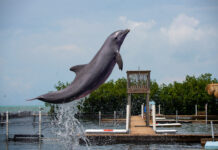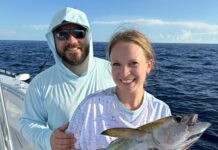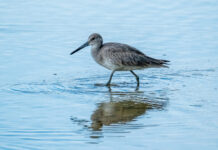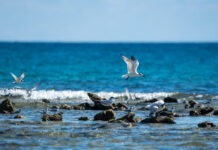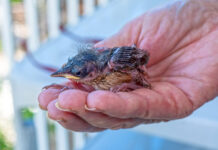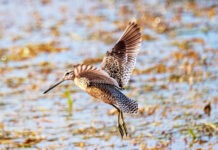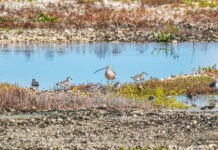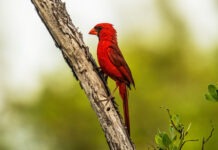The flamingo was in the ugliest part of the pond. Out in the middle, where it was probably about a foot deep, the surface was smooth and unbroken, reflecting the lovely hues of a later summer early evening. But the flamingo was working the edge of the pond, where the water looked to barely cover its feet and the surface was pocked with little piles of mud, giving it a somewhat blotchy, and decidedly less photogenic, appearance.
The flamingo had been there in the same pond on Grassy Key for more than a week. A half-dozen photographers I knew had posted photos – great photos that showed that flamingos aren’t just pink, but a subtle melange of rose, apricot, salmon, tangerine, Halloween orange, ecru and tacao. Great photos that showed the flamingo with its neck curved into a perfect S, or with its leg lifted, or with water droplets dripping off the end of its bill, big puffy clouds and a moonstone-blue sky reflected in the water.
And I had gone to the effort to get in my car, deigned to cross Cow Key Channel Bridge, and then drove an hour farther north. What did I get? A distant pink bird wading through the aquatic equivalent of acne.
Which proves once again that nature doesn’t care about your ego, your sense of entitlement, your aesthetic sensibilities or your artistic insecurities. Or at least she doesn’t care about mine.
Still, it was a real live American flamingo, just standing there out in the wild, as if it was some sort of everyday bird. I figured I might at least watch for a while.
Usually, when I see flamingos feed, they almost fully extend their neck and plunge their head down a few inches beneath the water, close to their feet. But this bird wasn’t doing that. Instead he was slow-stepping through two or three inches of water, his head upside down, but just breaking the surface of the water like a boat, or more specifically, a tugboat pulling his body along. Which got me curious.
It feels disingenuous to say flamingos are a rarity in the Florida Keys, at least in recent times, when a few have been reported consistently every year. I’ve probably had about two dozen sightings in the U.S., which is not something I take for granted.
Multiple early naturalists in the Keys reported flocks of 500 flamingos off Indian Key. W.E.D. Scott, head of ornithology at Princeton University, wrote of seeing a line of flamingos over a mile long while sailing off of Cape Sable. But the species was essentially eradicated in the U.S. by the plume hunters of the late 1800s and early 1900s, and any birds seen in the decades after were thought to be escapees from Florida institutions like Hialeah Race Track or Cypress Gardens.
Recently, 125 American flamingos were counted during an aerial survey of Florida Bay, 122 of them in flight in the same flock. The number has been pretty steady in size since Hurricane Idalia blew them all over from the Yucatan in 2023. And a flamingo known as both Peaches and US02 was spotted in the Yucatan helping to raise a chick, meaning once-broken migratory pathways may be being repaired.
The American flamingo seems to be slowly repopulating its historic ecological niche. At least that’s what many people hope these more regular sightings mean.
The reason for the Grassy Key flamingo’s solo status was known only to him, but flamingos spotted in the U.S. are often alone, possibly because they are on the edge of their range.
One of my favorite things about flamingos is how they feed. They are filter feeders, kind of like whales. But where whales use a ram filtration feeding model, propelling themselves through clouds of krill and filtering them through their baleen, flamingos rely on their tongues and feet.
Flamingo tongues are so muscular they were once served as a delicacy. The muscularity allows the tongue to work like a piston, drawing water in and then expelling it.
For a better understanding of the subtleties of a flamingo’s mouth, I tracked down a paper with the approachable title of “Filter Feeding in Flamingos (Phoenicopterus ruber),” which was published in the journal The Condor in 1995. Everything that came after the title sent me scuttling to Google or the dictionary. The paper’s abstract contained such easily penetrable linguistic gems such as, “We present a provisional morphospace of avian filter feeding mechanisms derived by nomological deduction from an initial pecking mechanism and develop in this domain preliminary historical-narrative hypotheses of the evolution of avian filter mechanisms.”
Despite my English-major understanding of the world, I bravely carried on, which was good, because the actual text of the paper was far more comprehensible. Plus, there were pictures.
Essentially, flamingos want to eat things between 0.1 mm and 4 mm in size. Brine shrimp, fly larvae, seeds, small mollusks, the occasional bit of algae found in the muck. To do this they tend to leave a gap of 1 to 4 mm between their upper and lower mandibles. A series of spiny tooth-like structures along the edges of each mandible called lamellae work as a kind of mesh to keep oversized objects out. Food gathers on the tongue, then is swallowed, shepherded by a series of lamellae on the back part of the tongue.
If they had a long, straight bill like, say, a heron, it would be hard to keep that gap consistent, as it would widen the closer it got to the end of the bill. But flamingo bills bend about 60 degrees at their midpoint, allowing the gap to stay consistent.
More recently (May of this year), a paper was published in the Proceedings of the National Academy of Sciences with the title “Flamingos use their L-shaped beak and morphing feet to induce vortical traps for prey capture,” a less succinct title at the top of a far more readable paper.
The paper documented how flamingos – specifically closely-related greater flamingos and the American flamingos – use hydrodynamics to catch their (very small) prey in four different ways.
Flamingos feed with their heads hanging upside down, sometimes partially under water, sometimes totally under water.
Sometimes you see them seemingly march in place, stamping their feet up and down while locomoting anywhere. This creates vortices, or little tornadoes that swirl up, concentrating prey inside of them, which they can then dip into and filter with their bill. Sometimes they will do what’s called chattering, opening and closing their bill quickly, which can increase what they capture by about sevenfold.
Sometimes they will push their head down to the bottom of the water and lift it up, creating a vertical vortex, from which they will filter prey.
The behavior I was witnessing is described in the paper as a recirculation trap, wherein they drag their partially submerged bill upside down along the surface of the water, like a boat, with eddies that concentrate the prey forming at the backward-facing tip of the bill. Which was edifying to learn.
A few days after I went up to Grassy Key, I ran into photographer Rob O’Neal while we were both taking pictures of people eating Key lime pie without using their hands. Rob asked if I’d gone up to see the flamingo. I told him my experience. He said he’d gone up twice, but the flamingo had stayed at the far end of the pond.
So I guess I’m ahead of the game. Unless I make a little more effort.






